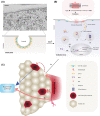Caveolae and the oxidative stress response
- PMID: 37248872
- PMCID: PMC10317157
- DOI: 10.1042/BST20230121
Caveolae and the oxidative stress response
Abstract
Oxidative stress is a feature of many disease conditions. Oxidative stress can activate a number of cellular pathways leading to cell death, including a distinct iron-dependent pathway involving lipid peroxidation, termed ferroptosis, but cells have evolved complex mechanisms to respond to these stresses. Here, we briefly summarise current evidence linking caveolae to the cellular oxidative stress response. We discuss recent studies in cultured cells and in an in vivo model suggesting that lipid peroxidation driven by oxidative stress causes disassembly of caveolae to release caveola proteins into the cell where they regulate the master transcriptional redox controller, nuclear factor erythroid 2-related factor 2. These studies suggest that caveolae maintain cellular susceptibility to oxidative stress-induced cell death and suggest a crucial role in cellular homeostasis and the response to wounding.
Keywords: Cavin1; NRF2; caveolae; cell death; lipid peroxidation; oxidative stress.
© 2023 The Author(s).
Conflict of interest statement
The authors declare that there are no competing interests associated with the manuscript.
Figures

References
-
- Dunnill, C., Patton, T., Brennan, J., Barrett, J., Dryden, M., Cooke, J.et al. (2017) Reactive oxygen species (ROS) and wound healing: the functional role of ROS and emerging ROS-modulating technologies for augmentation of the healing process. Int. Wound J. 14, 89–96 10.1111/iwj.12557 - DOI - PMC - PubMed
Publication types
MeSH terms
Substances
LinkOut - more resources
Full Text Sources

